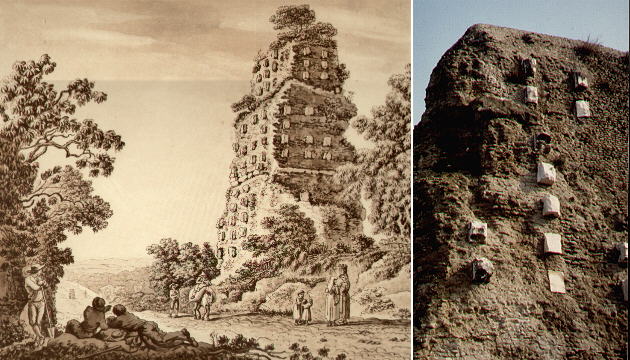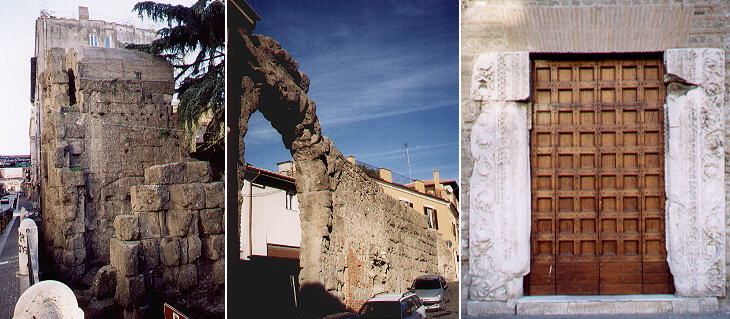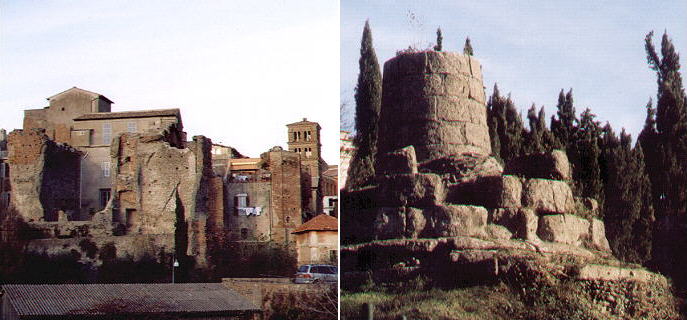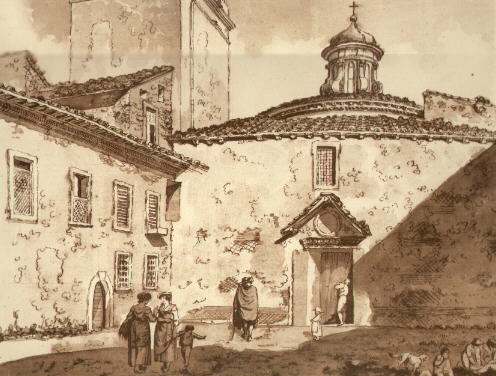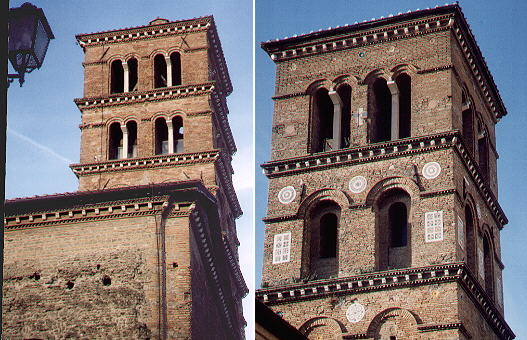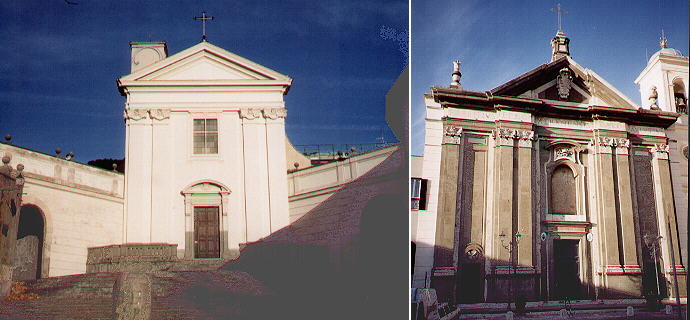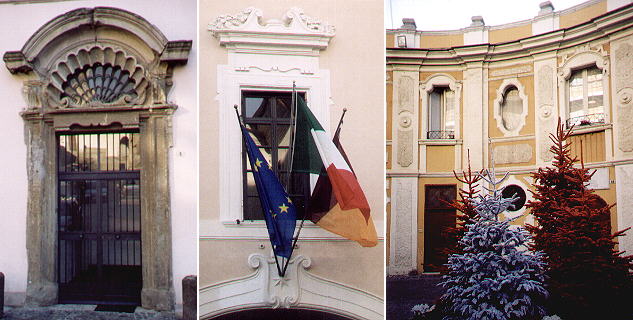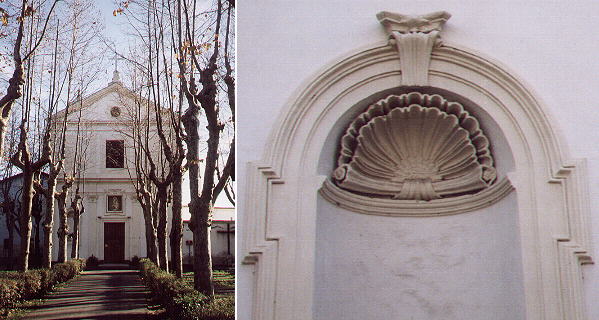

According to the legend Alba Longa was founded by Ascanius, son of Aeneas, the Trojan hero from
whom the Romans claimed to descend. Because Ascanius had seen in a dream a white sow he named the town Alba which in Latin
meant white (hence we call albino a person with a congenital absence of colouring pigment). Longa was a reference to the shape of the town.
A white sow is the symbol of today's Albano.
Alba Longa was in easy reach from Rome as it was located on the Via Appia and the emperor
Domitian (Ist century A.D.) built there a large villa. Later on the villa was thought to have belonged to Pompey and therefore
a tall tower near the entrance of today's Albano was called after him.
Roman ruins outside Albano in a 1796 drawing by Carlo Labruzzi and today
The expansion
of Alba Longa occurred at the beginning of the IIIrd century when the emperor Settimius Severus built there an encampment (Castra Albana)
to host a legion he trusted.
Ruins of the main and of the eastern gates; Roman reliefs at the entrance of S. Pietro
The encampment had the typical design of the Roman castra with a rectangular shape and two main roads
dividing it into four identical quarters. In 1944 Albano suffered heavy bombing and the collapse of a building brought to light that
it was incorporating the ancient main gate of the Roman town.
Caracalla's Baths and Tombs of the Curiazi
The emperor Caracalla, son of Septimius Severus, built large baths for the legionaries staying in Castra Albana to gain
their favour as he had killed his
brother Geta and feared their reaction. Imposing walls (in part incorporated into later buildings) are still visible at the lower end of the town, while a large cistern at its upper end
provided a regular supply of water. Outside Alba Longa there are some unusual tombs with a conic turret upon a square base. They
were thought to be the tombs of the Curiazi, the three brothers of Alba Longa who fought against the Orazi, three Roman
brothers, in a duel which replaced the actual fighting between Rome and Alba Longa (two tombs called after the Orazi can be seen along Via Appia).
S. Maria della Rotonda in a 1796 drawing by Carlo Labruzzi
During the Middle Ages the town was abandoned and only in the XIIth century it became important again for its
strategical location on Via Appia. It became a fiefdom of the Savelli family to whom it belonged until 1697 when it was acquired
by Camera Apostolica and it became a direct possession of the pope (the papal villa of Albano belongs to the Holy
See). During this period many churches were built making use of Roman buildings and Albano too has a sort of
Pantheon (Santa Maria della Rotonda) which exploits a nymphaeum of Domitian's villa.
Bell towers of S. Pietro and of S. Maria della Rotonda
The bell towers of Albano medieval churches are very similar to those one can see in Rome.
S. Paolo and the Cathedral
In the XVIIIth century Albano became the summer residence of several important Roman families and its population increased
in a significant manner. In 1721 a large cathedral was designed by Francesco Buratti and later on at the top of the hill the church of
S. Paolo was given a new faēade.
Entrance of a palace in Piazza S. Paolo, a window of Palazzo Savelli Albani and the exedra opposite Palazzo Lercari
Other XVIIIth century buildings can be found by walking in the (crammed) streets of today's Albano.
S. Maria della Stella
The church of S. Maria della Stella, located in a peaceful spot on the road which once led to Ariccia, was largely restored at the end of the XVIIth
century and it got a very elegant stucco decoration.
Read Lord Byron's verses dedicated to Albano.
Excerpts from Giuseppe Vasi 1761 Itinerary related to this page:
Cittą di Albano
Uscendo fuori della porta s. Sebastiano, e camininandosi per la via Appia, dopo le rovine del
Circo di Caracalla, e del sepolcro di Metella,
ora detto capo di Bove, evvi la villa delle Frattocchie, oggi de' Colonnesi, in cui fu la deliziosissima villa di Claudio Cesare, facendone
testimonianza le tante raritą, che vi sono state trovate, fra le quali il prezioso bassorilievo di Omero. Dipoi seguitando per la strada a
sinistra, si rintraccia la via Appia, e poco dopo si vede la moderna cittą di Albano.
Da Ascanio figliuolo di Enea, come dicemmo, fu edificata Albalunga per un sogno, che egli aveva avuto, che una troja bianca, ivi aveva
partorito 30. porchetti bianchi, per lo che Alba volle chiamare la sua cittą, e Lunga la disse, perchč sulla sommitą del monte fabbricolla
intorno al lago, occupando Castel Gandolfo, il convento de' Zoccolanti, fino a Palazzolo, e formandola di figura lunga quasi circolare,
come ne fanno fede i vestigj colą trovati in tempo di Alessandro VII. ed ancora le tre ruvide moli, che si vedono sulla via Appia, nelle quali
furono riposte le ossa, secondo che si legge, de valorosi Curiazj.
Distrutta poi da' Romani quell'insigne cittą, fu edificata la nuova, non gią sull'alto del colle, ove era l'antica: ma sulla costa verso ponente,
appunto ove era la sontuosa villa di Pompeo Magno, della quale se ne vedono ancora le rovine; ed il teatro di Domiziano, destinato ai giuochi
pubblici di fiere, di gladiatori, e di zuffe militari, e secondo che si legge, vi si facevano ancora i letterarj congressi di Poeti, Oratori, e d'Istrioni,
di cui se ne vedono similmente le rovine. Eravi il tempio di Venere e della buona Dea, l'uno da un canto, e l'altro dall'altro canto del sotterraneo
condotto, ovvero maraviglioso Emissario dell'acqua, lungi due miglia dal Lago, che ora dicesi di Castel Gandolfo. Fuvvi ancora la villa di
Clodio, ucciso da Milone, mentre tornava dalla Riccia, disceso poi da Cicerone, e si comprende nella di lui orazione la magnificenza di
quella villa. Ora per la salubritą dell'aria, e per l'amenitą del campo, e ambiente marittimo, vi sono moltissimi casini della primaria nobiltą Romana.
|
Next step in your tour of the Environs of Rome: Castelgandolfo
See my Home Page on Baroque Rome or my
Home Page on Rome in the footsteps of an
XVIIIth century traveller.
|


